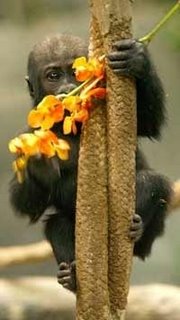A Feast for the Senses

Might a gorilla want to smell the flowers? A tapir try an artichoke? Chicago Zoological Society professionals at Brookfield Zoo really push the envelope when it comes to animal well being. And what they come up with is always eclectic, exciting, and of course, extremely eco-friendly.
Giant banana leaves, assorted fruits, orchids, bamboo, grapevines. These are just some items harvested from the zoo grounds during the year and delivered to animals as part of the weekly Browse Program.
So, what is “browse” exactly?
Traditionally, this word refers to trees, leaves, bushes, and other plant life that is consumed by “browsers,” or animals that feed on these items rather than graze from the ground.
Some famous browsers include elephants, giraffes, rhinos, and okapi—each of which are equipped with special adaptations to make leaf-picking a cinch. Elephants have that long, sensitive trunk to reach up high and grab branches. Black rhinos have a hooked lip for pulling, and giraffes and okapi have a special tongue for stripping leaves.
Nontraditional browsers, however, also benefit from the program at Brookfield Zoo. Carnivores, primates, birds, and reptiles receive special deliveries from keepers each week to provide sensory enrichment.
Not Just for Eating
The Browse Program aims to spark curiosity and encourage the animals to explore their senses with unique smells, tastes, and textures.
“Although a lot of the animals do consume the leaves and flowers we give to them, “says Tim Sullivan, Chicago Zoological Society Behavioral Husbandry Manager, “our goal is not only to moderate their diet and spark play. We are also looking to interest them in exploring the smells and visual aspects of each browse item.”
“Think of how we humans might hold up a flower or candle to smell it. This isn’t play necessarily, but a simple exploration that enriches our life experience.”
Creating Connections
Arborists, grounds crew, keepers, and even children, get involved with the Browse Program. The arborists cut back trees as part of their seasonal care. Grounds crew members gather the removed branches and leaves, and keepers help with the delivery and maintenance of special browse gardens throughout the zoo. This is where the kids come in.
Children of all ages pitch in by growing plants and flowers at the Hamill Family Play Zoo greenhouse. Then, during special events, they form harvest parades and help carry items off to the animal exhibits.
“It’s amazing to see the looks on their faces,” says Dave Becker, Associate Director of Learning Experiences. “The kids are just thrilled to watch a gorilla playing with leaves from a banana tree that they helped grow. The connections make an impact that I hope will inspire for a lifetime.”
The Women’s Board of Chicago Zoological Society also plays an active role in the program. They help fund browse gardens around the zoo, and this year they also supported and planted a new one outside the Butterflies! exhibit. Guests can view the lovely flowers and watch as native birds and other creatures feast and explore. This garden is on a trimming schedule as well so that the blooms and leaves are shared with animals across the zoo.
Browse in Your Backyard*
If all the browse talk has you excited, then take a look at this list of things you can do at home to enrich life for your pets!
- Grow cat nip for your favorite feline.
- Try planting a variety of herbs for your dog to explore new scents.
- If you have a rabbit, or simply love the wild ones, consider leaving the dandelions for them. Or grow some carrot tops and parsley.
- Flowering plants are a favorite of pet birds, and native wild ones alike! Color your garden with all sorts of flowers and you will attract butterflies, too.
When you visit the zoo this summer or fall, likely on a Wednesday or Thursday, you may be lucky enough to find an animal with a newly delivered bundle of browse! Their reactions are really awe-inspiring to witness. And fear not, in the winter the Browse Program forges on. Keepers and other crew members have collected excess items to store for later use. This bulk supply will be kept fresh all winter long in a special seasonal area, a place only left empty in cold weather: the ice cream freezer.
Photo credit: Chicago Zoological Society at Brookfield Zoo

0 Comments:
Post a Comment
<< Home